Empower EFL Students to Reduce Their L2 Lexical Errors Caused by L1 Semantic Interference
Wei-Wei Shen and Mei-Li Chou, Taiwan
Wei-Wei Shen is an associate professor of Feng Chia University, and an advisory member of English Language Education Board in Taichung City Council, Taiwan. Her research interests include vocabulary teaching and learning, cultural keywords, and academic writing.
E-mail: wwshen@fcu.edu.tw
Mei-Li Chou is a lecturer of the Department of Foreign Languages and Literature, Feng Chia University, Taiwan. She has been teaching English writing for more than twenty years.
Menu
Introduction
Review of the former studies on confusable translations from L1 into L2
The present study: materials and methods
Training students to avoid the L2 lexical errors due to L1 translations
A humanistic teaching activity for L2 lexical error correction
Conclusion
References
Investigating EFL learners’ errors in L2 vocabulary caused by their L1 is an important issue in L2 acquisition and pedagogy (e.g. Laufer, 1997; Swan, 1997), because when EFL teachers are sensible to lexical errors deriving from students’ own L1, students can be guided to learn L2 with less difficulty, confusion and stress. This implication is particularly important for ELT instructors teaching writing in the EFL context, such as in Taiwan, because there are far too many errors in vocabulary made in the students’ English writings. We find that many errors may occur when L2 learners try to, consciously or unconsciously, translate L1 lexemes that are semantically the same as or similar to their L2 equivalents. The most basic and direct causation of the errors, then, can be attributed to the differences between L1 and L2. As a result, not only students but also teachers have huge concern and frustration about these errors.
As we are aware that on the basis of the humanistic viewpoints of teaching (e.g. Brown, 2000; Harmer, 2001), it is good to reduce learners’ anxiety, boost their confidence and promote self-discovery in the L2 learning process. So our paper intends to, on the one hand, highlight Taiwanese university students’ errors which can be easily brought about, especially when a single Chinese character or word has different English equivalents in Taiwanese EFL students’ compositions. This particular source of confusing translations will be shown through our longitudinal collections of students’ writing production over four years. On the other hand, at the end of the paper, we will propose a humanistic teaching activity that cannot only enhance students’ awareness of the selected common errors, but also increase learners’ autonomy to solve their lexical problems.
Due to a huge population of Chinese speakers learning English as an L2, it is expected that our article may sharpen the understanding of the real cases of L1 semantic interference through the analysis of some confusable L1 translations, i.e. Chinese in this case, when students learn English as an L2, so as to provide feasible suggestions to improve this kind of writing difficulty.
Although some book authors attempted to record common confusable pairs of words or phrases that easily cause errors of L2 learners (Canning, 1986; Fitikides, 1963; Potter, 1992; Tan, 1986; Turton & Heaton, 1996; Zyzo, Santomé, & Heins, 2005), they did not indicate the reasons for these errors. Therefore, in this section we will classify the common kinds of confusable pairs of words or phrases in English mentioned by the above books, and we further analyze the origins of these errors accordingly.
Table 1. Confusable pairs of words in L2 (English) resulting from their same meanings or characters in L1 (Chinese)
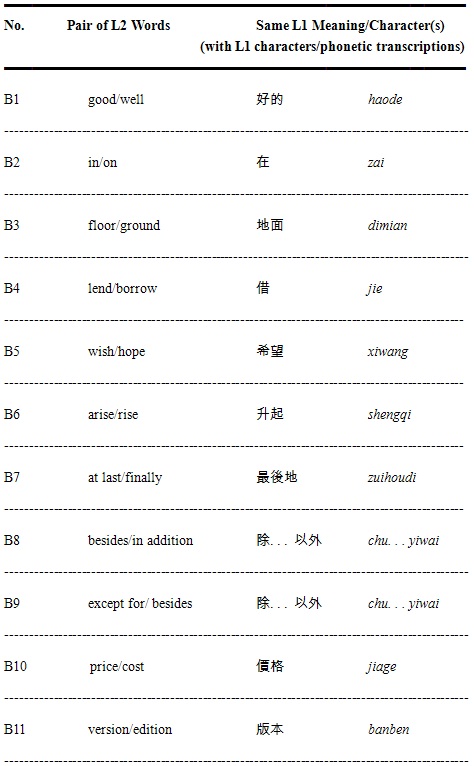
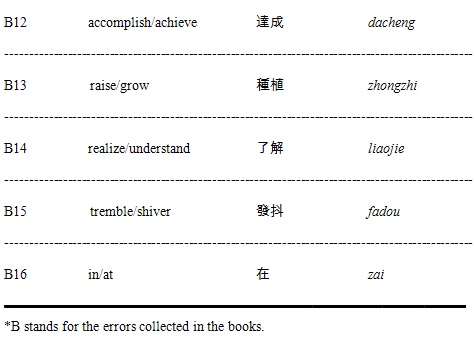
Apparently, the 16 pairs of confusable words or phrases in Table 1 share one quality; namely, although the English words or phrases in each pair are two different words which mean differently, their Chinese equivalents are exactly the same. Unsurprisingly, L2 learners may find difficulty using the right words in their sentences.
Examples of the typical errors in use based on the former studies are shown below.
| (B1) |
(x) He speaks English good.
(o) He speaks English well. (Tan, 1986, p. 85)
|
| (B2) |
(x) In 1st July we went to Italy by car.
(o) On 1st July we went to Italy by car. (Turton & Heaton 1996, p. 172)
|
| (B3) |
(x) He fell on the floor when he was walking outside.
(o) He fell on the ground when he was walking outside. (Zyzo et al., 2005, p. 36)
|
| (B4) |
(x) I want to lend a book from you.
(o) I want to borrow a book from you. (Fitikides, 1963, p. 103)
|
| (B5) |
(x) I wish we will meet again soon.
(o) I hope we could raise everyone’s salary. (Potter, 1992, p. 212)
|
| (B6) |
(x) The price will arise in April.
(o) The price will rise in April. (Zyzo et al., 2005, p. 7)
|
| (B7) |
(x) At last, I’d like to thank everyone in my department for their help.
(o) Finally, I’d like to thank everyone in my department for their help.
|
| (B8) |
(x) We need paper. Besides, we need some toner.
(o) We need paper. In addition, we need some toner. (Zyzo et al., 2005,
p. 15)
|
| (B9) |
(x) Except for increasing sales, the activity will be beneficial for our
image.
(o) Besides, increasing sales, the activity will be beneficial for our
image. (Zyzo et al., 2005, p.34)
|
| (B10) |
(x) The price of living is very high in this country.
(o) The cost of living is very high in this country. (Zyzo et al., 2005,
p. 78)
|
| (B11) |
(x) I have attached the second and final edition of the marketing
proposal.
(o) I have attached the second and final version of the marketing
proposal. (Zyzo et al., 2005, p. 30)
|
| (B12) |
(x) To accomplish world unity, we need peace.
(o) To achieve world unity, we need peace. (Turton & Heaton 1996, p.
5)
|
| (B13) |
(x) When I was a child, I used to raise my own flowers in a corner of
the garden.
(o) When I was a child, I used to grow my own flowers in a corner of
the garden. (Turton & Heaton 1996, p. 276)
|
| (B14) |
(x) The criminal mind is not always easy to realize.
(o) The criminal mind is not always easy to understand. (Turton &
Heaton 1996, p. 279)
|
| (B15) |
(x) It was so cold that I couldn’t stop trembling.
(o) It was so cold that I couldn’t stop shivering. (Turton & Heaton, 1996, p. 337)
|
| (B16) |
(x) I work in Tiptop Trading Company.
(o) I work at Tiptop Trading Company. (Canning, 1986, p. 113)
|
Because of the identical Chinese equivalents, these confusable pairs of words have become fossilized errors for many Taiwanese university students. Among these pairs, we noticed that the more confusable ones can be B2 and B16, for the three English words in, on, and at can be translated into only one Chinese character 在 (zai). This has resulted in many L2 learners’ inability to distinguish the differences between them. Therefore, to directly explain the differences in using them is always necessary.
Moreover, another kind of common L2 errors is caused by similar L1 (Chinese) translations in L1 per se. In the following table, from the items B17-25, we can see that although two different English words can have two different Chinese translations, the two Chinese translations look similar. They not only contain one or more than one same Chinese character of each term, but also have very similar L1 meanings. These pairs of L1 translation need to be used in real context so that their subtle differences can be easily clarified.
Table 2. Confusable pairs of words or phrases in L2 (English) resulting from sharing one or two or three same L1 (Chinese) characters

| (B17) |
(x) The latest election was won by the socialists.
(o) The last election was won by the socialists. (Turton & Heaton,
1996, p. 195)
|
| (B18) |
(x) We need more efficient ways of dealing with the pollution or the
problem will get worse.
(o) We need more effective ways of dealing with the pollution or the
problem will get worse. (Turton & Heaton, 1996, p. 113)
|
| (B19) |
(x) Most of our clients like our new product.
(o) Most of our customers like our product. (Zyzo et al., 2005, p. 19)
|
| (B20) |
(x) Their fees raised last year.
(o) Their fees rose last year.
(o) The company raised their fees last year. (Potter, 1992, p. 97)
|
| (B21) |
(x) We ensure you that we will do our best.
(o) We assure you that we will do our best. (Turton & Heaton, 1996, p. 119)
|
| (B22) |
(x) I’m doing the course to expand my job opportunities.
(o) I’m doing the course to increase my job opportunities. (Turton &
Heaton, 1996, p. 126)
|
| (B23) |
(x) At first, I would like to introduce myself.
(o) First of all, I would like to introduce myself. (Turton & Heaton, 1996, p. 138)
|
| (B24) |
(x) There are four points that I would like to make about the college. At
first, there are not enough club activities.
(o) There are four points that I would like to make about the college.
Firstly, there are not enough club activities. (Turton & Heaton, 1996, p. 138)
|
| (B25) |
(x) We would like to pass our holidays near the sea.
(o) We would like to spend our holidays near the sea. (Turton & Heaton, 1996, p. 255)
|
After reviewing the existing common types of L2 (English) errors caused by L1 (Chinese), we then updated and added up more pairs of words based on our students’ writings.
All the data were collected from 530 university students in our various classes during these four years in Taiwan including the courses of English Essay Writing, Research Paper Writing, and Business English.
Our students were in the intermediate range of English proficiency averagely, and this is the level that students suffer from the ‘plateau effect’ and need to be pushed further in order to make progress in their learning. Moreover, our students normally did not show much confidence in using English because they mentioned that they are afraid of making errors. In fact, they considered that the level of their English competence depends much on the accuracy of using English. On the other hand, our Taiwanese colleagues normally find corrections of the frequent lexical errors tiring, and students’ repeatedly same mistakes make them wonder if the random corrections in students’ writings useful. So the analysis and treatment of their common errors presented in our paper can be helpful.
Based on the data, we judged and compared the frequencies of the students’ errors. In the following tables, we arranged the terms in each table in descending order. That is, the one on the top could be wrongly used more often in our students’ writings.
Table 3. High-frequency confusable pairs of words in L2 (English) resulting from their same meanings or characters in L1 (Chinese)
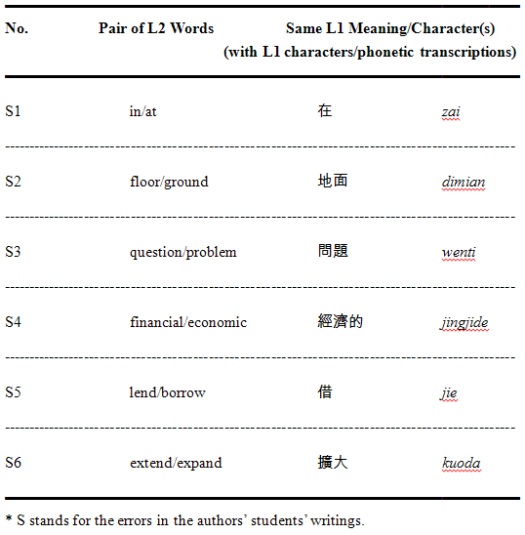
Table 3 shows 6 pairs of confusable words whose frequency of occurrence is very high. Among them, items S1, S2, and S5 have also been listed in the above-mentioned books as common errors, that is, B16, B3, and B4 in Table 1. The very high frequency of the occurrence of these errors clearly suggests that many EFL learners in Taiwan are unable to use these L2 words correctly because the L1 equivalents of each pair of words are identical. When the learners write in L2 (English) but think in L1 (Chinese), they are apt to make these errors in word choice again and again. Examples of these three pairs are shown as below:
| (S1) |
(x) Now I am studying for the master’s degree in Feng Chia University and
majoring in information engineering and computer science.
(o) Now I am studying for the master’s degree at Feng Chia University and
majoring in information engineering and computer science.
|
| (S2) |
(x) I fell over a chair and dropped all the files to the ground.
(o) I fell over a chair and dropped all the files to the floor.
|
| (S3) |
(x) When I face some difficulties, talking to my friends is a way to solve my
questions.
(o) When I face some difficulties, talking to my friends is a way to solve my problems.
|
| (S4) |
(x) Therefore, in her mind, the first step to be successful is her economic
independence.
(o) Therefore, in her mind, the first step to be successful is her financial
independence.
|
| (S5) |
(x) Besides, she liked to lend money from her good friends, but she never
returned it to them. Now her friends regard her as a plague.
(o) Besides, she liked to borrow money from her good friends, but she never
returned it to them. Now her friends regard her as a plague.
|
| (S6) |
(x) Moreover, it is more convenient to extend the hardware in the desktop.
(o) Moreover, it is more convenient to expand the hardware in the desktop.
|
Table 4. Lower-frequency confusable pairs of words in L2 (English) resulting from their same meanings or characters in L1 (Chinese)
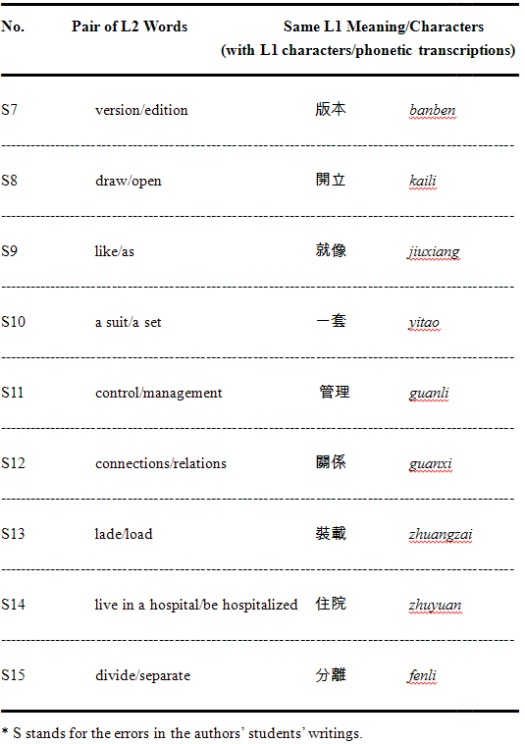
Of the 9 low-frequency confusable pairs of words and phrases in Table 4, the first pair S7 is also listed in Table 1 as B11. Although it occurs in students’ writings from time to time, till the present very few students have used the two words correctly because the Chinese translations of them are entirely the same. In addition, the other 8 pairs from S8 to S15 are confusing to many L2 learners. Some examples of them drawn from students’ compositions are shown below.
| (S7) |
(x) I am very confused. Which edition of the story is true?
(o) I am very confused. Which version of the story is ture?
|
| (S8) |
(x) Please open a draft on us for the total amount of US$112,000.00.
(o) Please draw a draft on us for the total amount of US$112,000.00.
|
| (S9) |
(x) Please send us all the documents like mentioned above by
express mail.
(o) Please send us all the documents as mentioned above by
express mail.
|
| (S10) |
(x) I need to buy a new suit of underwear.
(o) I need to buy a new set of underwear.
|
| (S11) |
(x) Having controlled time well, I can be not only respected by my
friends but also seldom late on any date.
(o) Having managed time well, I can be not only respected by my
friends but also seldom late on any date.
|
| (S12) |
(x) One of the qualifications for being an agent is good market
relations.
(o) One of the qualifications for being an agent is good market
connections.
|
| (S13) |
(x) After shipment, please send us a copy of bill of loading.
(o) After shipment, please send us a copy of bill of lading.
|
| (S14) |
(x) I had lived in a hospital for a week.
(o) I had been hospitalized for a week.
|
| (S15) |
(x) We used to divide the two steps, but now we hope to deal with
both the power routing and floorplan at the same time.
(o) We used to separate the two steps, but now we hope to deal with both the power routing and floorplan at the same time.
|
Table 5. High-frequency confusable pairs of words in L2 (English) resulting from sharing one same character in their meanings in L1 (Chinese)
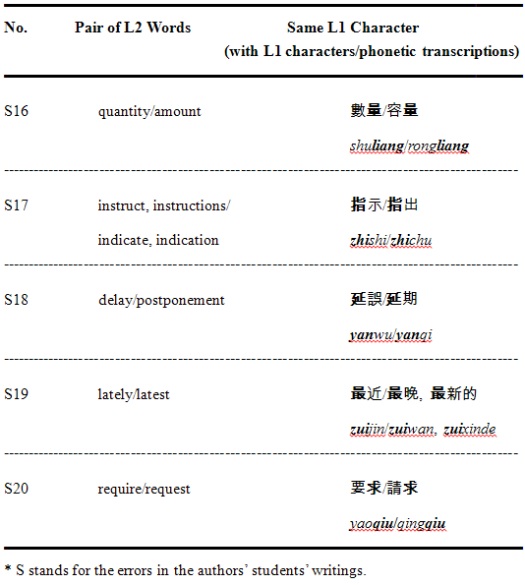
Table 5 has listed another type of frequently incorrect consequences from the translating process. As can be seen in this table, the Chinese equivalents of the confusable pairs of words and phrases are not exactly the same—they just contain one same Chinese character in two different ways: either the initial character or the second character of each pair is the same. But because of this partial resemblance in their L1 translation, L2 learners find it difficult to distinguish between the two L2 lexemes and constantly make the errors, which are exemplified as follows.
| (S16) |
(x) You shipped an excess amount of Item No. 101.
(o) You shipped an excess quantity of Item No. 101.
|
| (S17) |
(x) According to your indications, we have enclosed a copy of our
sales confirmation acknowledging your order.
(o) According to your instructions, we have enclosed a copy of our
sales confirmation acknowledging your order.
|
| (S18) |
(x) We hope you will make arrangements to clear your account
without further postponement.
(o) We hope you will make arrangements to clear your
without further delay.
|
| (S19) |
(x) In reply to your inquiry, I am very glad to enclose a leaflet
showing our lately fax machines.
(o) In reply to your inquiry, I am very glad to enclose a leaflet showing our latest fax machines.
|
| (S20) |
(x) Shipment will be requested within 4 weeks of order.
(o) Shipment will be required within 4 weeks of order.
|
Table 6 below has shown only five of the lower-frequency confusable pairs of words. Similar to Table 2, the pairs in Table 6 may originate from sharing one same Chinese character in the L1 equivalents of each pair of words in three different ways: (1) the initial character of the first word of the pair is exactly the same as the second character of the other word of the pair; (2) the initial character of the first word of the pair is identical with the initial character of the other word of the pair; (3) the second character of the first word of the pair is also the initial character of the other. When the same character appears in different combinations forming L1 equivalents, the error in word choice is inevitable.
Table 6. Lower-frequency confusable pairs of words in L2 (English) resulting from sharing one or two same characters in their L1 (Chinese) equivalents

This kind of errors is demonstrated by the following sentences.
| (S21) |
(x) All the items ordered are in stock, except for Item No. 23, and the
manufacturers have informed us that they need another 4 weeks
before they can send substitutes.
(o) All the items ordered are in stock, except for Item No. 23, and the manufacturers have informed us that they need another 4 weeks before they can send replacements.
|
| (S22) |
(x) On campus, I often see many places or equipment being
repaired and renovated.
(o) On campus, I often see many places or facilities being repaired and renovated.
|
| (S23) |
(x) Without the invention of electricity, we would be living in an
original way.
(o) Without the invention of electricity, we would be living in a
primitive way.
|
| (S24) |
(x) I didn’t study as hard as I do and I became treasonable.
(o) I didn’t study as hard as I do and I became rebellious.
|
| (S25) |
(x) We hope you will make arrangements to clean your account
without further delay.
(o) We hope you will make arrangements to clear your account without further delay.
(x) There will be a clean sale in the department store.
(o) There will be a clearance sale in the department store.
|
The above frequently seen lexical errors made by EFL university students in Taiwan have shown that L1 translations are not always useful to produce correct L2 lexicon. Instead, L1 equivalents can be confusing and become a source of L2 errors. Therefore, students’ lexical errors should be reduced or even corrected by some autonomous strategies, that is, on the one hand, to raise students’ direct attention to these common errors as well as the proper use of L2 lexicon; on the other hand, to train students to be able to make corrections themselves instead of depending on teachers (Ancker, 2000).
Based on this main teaching criterion, one of the good methods helpful to raise learners’ consciousness of learning vocabulary is the use of dictionaries, because this cannot only draw students’ attention to the target words, but show them the usage of these words. Although the choice regarding using L1 or L2 glossaries and using printed or electronic type of dictionaries can be debatable (Bensoussan, 1983; Koren, 1997; Laufer & Melamed, 1994; Piotrowski, 1989; Stein, 1989; Walz, 1990), a dictionary without examples of using the words will not be a good option for EFL learners because this type of dictionary fails to show learners the real use and collocations of the L2 words.
On the other hand, it may seem arbitrary to prohibit the use of electronic types of dictionaries because students nowadays tend to rely on them. In fact, as long as using an electronic type of dictionary is guided by teachers’ instruction with the possibilities of exposing the ways of remembering and using the words, it is still an effective tool (Svendson, 2006). Or, alternatively, teachers can encourage students to use free online dictionaries more often, such as Dictionary.com or Yahoo dictionary. These recent online resources provide rich information on what words mean, how words can be used and pronounced, so learners can process L2 expressions with more exposure.
Another online tool called BNC (British National Corpus) can be also useful for students to check the concordance of the target words, because they can acquire the use and collocations of English words through real-life English. Loucky (2002) proved the effectiveness of using computerized dictionaries, so using online dictionaries to learn words should be encouraged and guided.
When considering the implementation of teaching in class, English teachers can design an activity incorporating the above-mentioned learning tools, in which teachers can guide the students to recognize the errors, to be able to differentiate between two confusable English words caused by L1 translations as shown in the above tables, and to strengthen students’ memory of the right usage of these confusable words.
In the following table, we exemplify an activity based on the humanistic nature of language teaching, which prioritize learners’ learning needs because our students are so eager to avoid making errors and to be more confident in using accurate English. On the other hand, our students are expected to be capable of managing their own lexical use in their writing so that they are not frustrated when they get a lot of corrections from their teachers. In the end, we hope that when correcting students’ common lexical errors in EFL class, teachers will be silent and passive, and students, active, motivated, and less anxious.
| Affective Aims |
1. To guide students to recognize their writing problems with word choice
2. To encourage them to correct the errors by themselves through team effort and cooperation
3. To increase students’ confidence in solving their own writing problems, especially in word choice
|
| Linguistic Aims |
To guide students to understand the differences between two confusable Chinese-English (L1-L2) equivalents and practice how to choose the correct one in their compositions |
| Levels |
Intermediate range |
| Learning Tools |
paper dictionaries, electronic dictionaries, dictionaries on the Internet, British National Corpus |
| Classroom |
a classroom with the internet service to be preferable |
| Procedures |
1. Divide students into groups.
2. The teacher gives each student a test in which there are 20 sentences randomly selected from those exemplified in this paper. Based on students’ current knowledge, they can simply give a check ‘v’ or a cross ‘x’ to each of the sentences to indicate whether it is correct or incorrect. The arrangement of the 20 sentences will, of course, be scattered to avoid the obvious contrast between the two sentences in a pair.
3. The teacher then waits for all groups to finish the test. Having finished the test, students in each group then check answers and discuss with one another about which sentences are right and which ones are wrong, and which pairs of words are confusable to them. Students are allowed to consult dictionaries if there is no “knower” in a group. Meanwhile, the teacher must patiently listen to them and try not to interfere with their discussion if students do not call for help or if they are not helpless to solve their problems.
4. When the teacher finds that the students have fully understood the meaning and the correct usage of each word, the teacher can give a second test. Therefore, it is expected that after having done the activity at least five times, students may not be confused about the kind of word choice, as classified in this paper.
|
Designed to be self-discovering without time limit and under an environment that is free, unthreatening, this kind of humanistic teaching activity not only adds some fun to the learning but also increase students’ impression of these confusable words so as to improve the situation gradually and effectively. Moreover, students can increase their talking time and become more autonomous in their own learning process.
This paper has used a case of Taiwanese university students’ English writings to analyze a specific cause of L2 lexical errors made by L1 equivalents. It has also come up with some feasible suggestions and solutions for the ELT teachers.
Our study may be arguably as an exploratory one because we can never assume that these are the only confusable pairs of words or phrases. In addition, there are differences of Chinese characters written in Mainland China and in Taiwan; the former is the simplified version, and the latter the complex one. But we hope that the approach to analyzing the types of errors may be used by other ELT teachers and researchers because the L1 interference in the use of L2 vocabulary was so obviously seen in students’ writings. If such commonly found errors can be classified and explained, EFL learners may deal with these fossilized errors more easily and independently. Future studies can be conducted to testify the effectiveness of the kind of humanistic teaching activity.
Ancker, W. (2000). Errors and corrective feedback: Updated theory and classroom practice. English Teaching Forum, 38 (4), 20-24.
Bensoussan, M. (1983). Dictionaries and tests of EFL reading comprehension. ELT Journal, 37 (4), 341-45.
Brown, H. D. (2000). Principles of language learning and teaching (4th Edn.). White Plains, N.Y.: Longman.
Canning, D. (1986). Common mistakes of Chinese students in English usage. Taipei: Crane.
Fitikides, T. J. (1963). Common mistakes in English with exercises. London: Longman.
Harmer, J. (2001). The practice of English language teaching (3rd Edn.). Harlow, Essex: Longman.
Koren, S. (1997). Quality versus convenience: Comparison of modern dictionaries from the researcher’s, teacher’s and learner’s points of view. TESL-EJ, 2(3). Retrieved March 7, 2010 from www-writing.berkeley.edu./tesl-ej/ej07/a2.html.
Laufer, B. (1997). What’s in a word that makes it hard or easy: Some interalexical factors that affect the learning of words. In N. Schmitt & M. McCarthy (Eds.), Vocabulary: Description, acquisition and pedagogy (pp. 140-55). Cambridge: Cambridge University Press.
Laufer, B. & L. Melamed. (1994). Monolingual, bilingual and ‘bilingualized’ Dictionaries: Which are more effective, for what and for whom? In W. Martin et al. (Eds.), EURALEX 1994 Proceedings (pp. 565-76). Amsterdam: International Congress on Lexicography.
Loucky, J. P. (2002). Improving access to target vocabulary using computerized bilingual dictionaries. ReCALL, 14 (2), 295-314.
Piotrowski, T. (1989). Monolingual and bilingual dictionaries: fundamental differences. In M. L. Tickoo (Ed.), Learners’ dictionaries: State of the art. Anthology Series 23 (pp. 213-221). Singapore: Southeast Asian Ministers of Education Organization, Regional Language Centre.
Potter, J. (1992). Common business English errors of Chinese students. Hong Kong: Longman.
Stein, G. (1989). Recent development in EFL dictionaries. In M. L. Tickoo (Ed.), Learners’ dictionaries: State of the art. Anthology Series 23 (pp. 10-41). Singapore: Southeast Asian Ministers of Education Organization, Regional Language Centre.
Swan, M. (1997). The influence of the mother tongue on second language vocabulary acquisition and use. In N. Schmitt & M. McCarthy (Eds.), Vocabulary: Description, acquisition and pedagogy (pp. 156-80). Cambridge: Cambridge University Press.
Svendson, A. (2006). The phenomenon of electronic dictionaries: Raising student awareness. The Language Teacher, 30(2), 17-21.
Tan, J. C. L. (1986). An analysis of errors in English composition. Taipei: The Fine Horse.
Turton, N. D. & J. B. Heaton. (1996). Longman dictionary of common errors. Harlow: Longman.
Walz, J. (1990). The dictionary as a secondary source in language learning. The French Review, 64 (1), 79-94.
Zyzo, W., K. Santomé, & D. Heins. (2005). 1001 common Chinese errors in English: Advanced level. Taipei: Crane.

Please check the Teaching Advanced Students course at Pilgrims website.


|